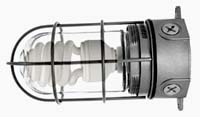|
By Jerry Tardif
Some horse owners are concerned about whether or not fluorescent lighting is dangerous to horses.
The light from a fluorescent bulb itself is not dangerous to horses or humans (nor to cats, dogs, barn swallows, etc., etc.)
While ultraviolet rays are produced by raising the energy levels of electrons in the mercury atoms within the fluorescent tube, almost all of those rays strike the phosphor coating on the inside of the bulbs surface causing it to emit visible light.
We have a long history of using fluorescent tubes and no currently known dangerous effects due to the use of that lighting form itself.
There is some danger if a fluorescent bulb were to be broken.
In that case, glass could "rain down" on a person or horse.
There would be a risk of being cut and of glass getting into the eyes.
A horse could also get hurt stepping on the broken glass.
In addition, the phosphor and the mercury contained inside fluorescent bulbs are toxic.
It would be bad for a person or horse to breathe either substance in or for any mammal to ingest it.
Fluorescent tubes contain more phosphor and mercury than compact fluorescent lights (CFLs).
If you use fluorescent tubes in a stall or the barn aisle, you should make sure they're high enough that a horse can't rear and touch them, or that you or someone else working in the barn can't accidentally hit the bulb with a board, rake, pitch fork, or shovel handle.
If the lighting fixture cannot be placed that high, you can slide clear plastic tubes over them.
These tubes are made specifically for that purpose and can be purchased at any home store.
In the event of a breakage, the plastic tube will contain the broken glass and other parts so they don't fall to the ground and onto horses or people.
If you use compact fluorescent lights that are very popular now, you can purchase sturdy, enclosed, glass fixtures (see below) that will protect the bulb if they, too, cannot be placed high enough to be out of reach.

|
In barns, consider enclosing any kind of bulb in a vapor proof fixture.
|
Don't avoid fluorescent lighting for safety reasons.
They're much more efficient and save significant amounts of electricity compared to incandescent bulbs.
And even incandescent bulbs can be broken, and therefore should also be enclosed in sturdy, enclosed, glass fixtures.
|
How Fluorescent Bulbs Work
|
|
Incandescent bulbs work by running an electric current through a wire filament causing it to heat enough to radiate visible light.
The only reason the filament doesn't immediately melt or burn out is because it's made of tungsten, which has a very high melting point of 6,192 °F (3,422 °C) and because there is no oxygen available for combustion because the air has been removed from the inside of the bulb during manufacture.
The problem is the fact that the primary output of this process is 90% heat and only 10% light.
Fluorescent lighting works differently.
Fluorescent bulbs are filled with an inert gas, a small amount of mercury, and the inside of the bulb is coated with a fluorescent phosphor.
When you turn one on, a small heating element at each end of the bulb causes some of the mercury to vaporize and become gaseous.
Mercury is a conductive metal and electricity is able to flow from the heating filament at one end of the bulb to the other even in its vaporous state.
This electric flow temporarily raises the energy level of the electrons in the mercury atoms to a higher level, but they quickly fall back to their normal level.
When that happens, the energy that initially raised their level is released as ultraviolet light (UV) which is invisible to us.
But when the UV strikes the phosphor on the inside of the bulb, the phosphor fluoresces brightly, thereby emitting the light we see.
Because the heating filaments at the ends of the bulb are small and give off little light and heat compared to an incandescent bulb, fluorescent bulbs give off much less heat.
The result is that this more complicated process generates the same amount of light as an incandescent bulb using only one quarter of the electric power.
This saves you 75% on the cost of electricity you would have spent using an incandescent bulb to get the same amount of light.
|
Besides being an avid trail rider, Jerry Tardif is a technology consultant and a horse and nature photographer in SE Connecticut — see his work at: www.jerrytardif.com.
He is also co-founder and President of QueryHorse.
Back to Article Index
|